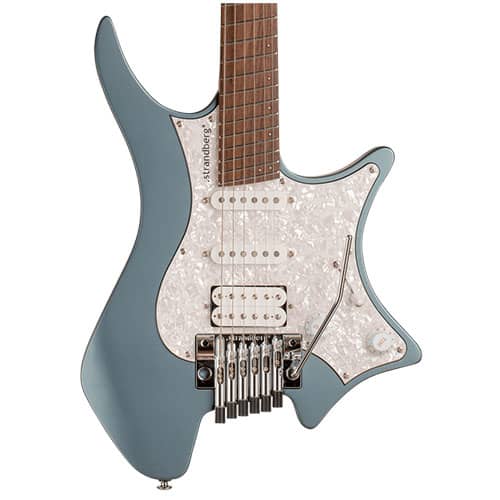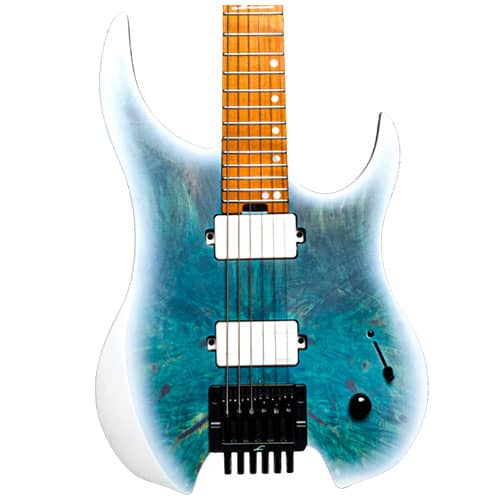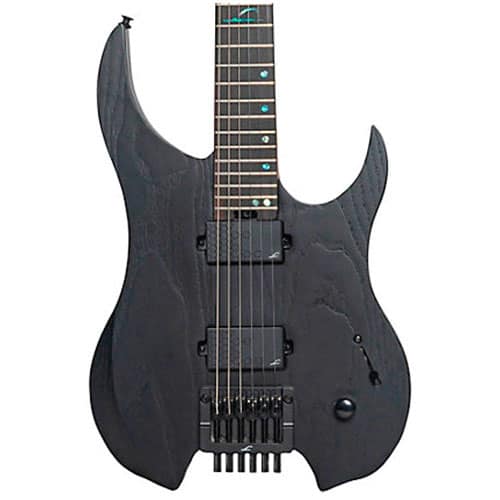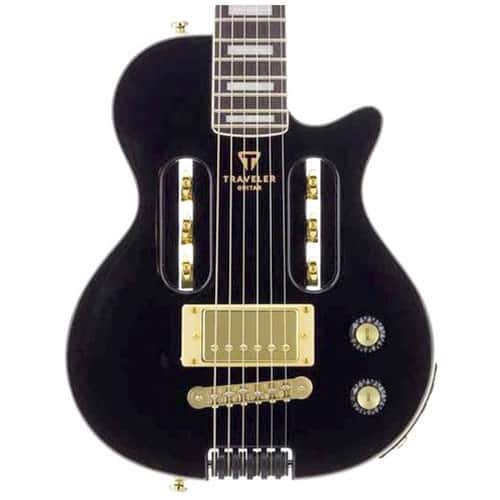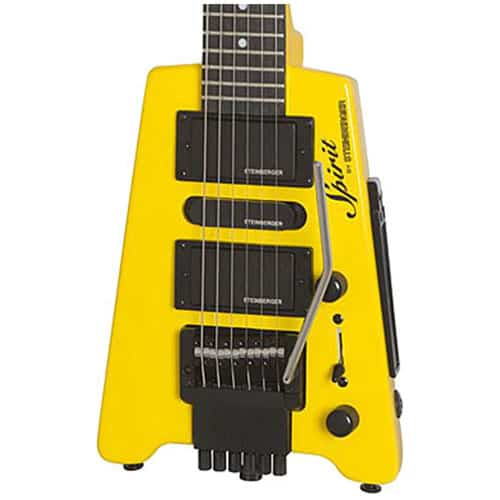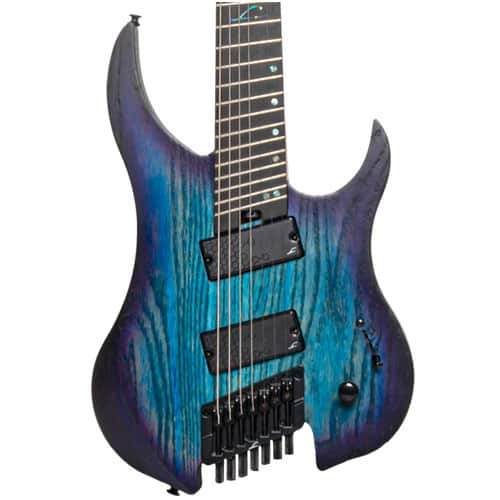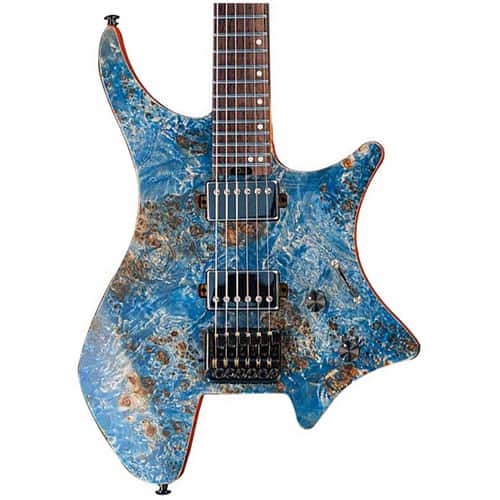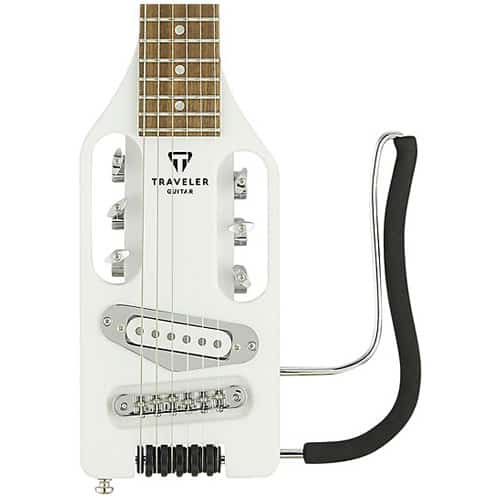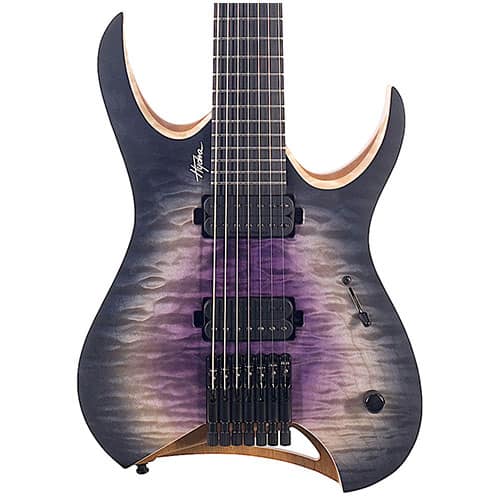Table of Contents
There are few things cooler than a headless guitar. With its sleek, stripped-back features and futuristic designs, it’s the perfect tool for players who want to look as good as they play.
After review, we picked the Strandberg Boden Classic 6 as the best headless guitar on the market. It’s versatile and sounds powerful without sacrificing build quality. Compared to other headless guitars, it also offers great value and finesse.
Strandberg is far from your only choice, however. There are plenty of other great manufacturers for headless guitars today. Our guide offers a review for nine of the best models around. So, check it out; you’re sure to find the perfect headless guitar for you.
The 9 Best Headless Guitars:
| Image | Headless Guitars | Summary | Check Price |
|---|---|---|---|
 | Strandberg Boden Classic 6 Trem Headless Guitar | Best Choice: Outstanding overall, with classic Strandberg quality and versatile tones | Check price |
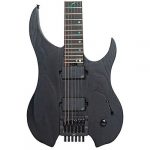 | Legator G6P Electric Headless Guitar | Best Value: Great hardware, body and tone for players on a budget | Check price |
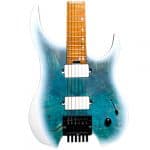 | Legator G6OD Electric Headless Guitar | Premium Pick: Beautiful tonewoods that are sure to turn heads, with the pickups and hardware to match | Check price |
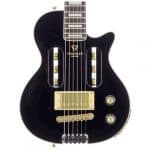 | Traveler EG 1 Custom Electric Headless Guitar | Great Travel Guitar: Tiny frame that’s built for travel, with a full scale and good pickup onboard | Check price |
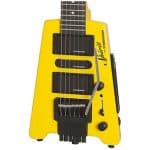 | Steinberger Spirit GT-PRO Deluxe Electric Headless Guitar | Classic Model for Budget Players: The classic Ned Steinberger body design, with versatile pickups and a great value | Check price |
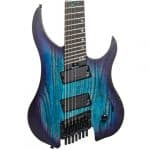 | Legator G7FP 7-String Electric Headless Guitar | Extended Scale and Good Value: Seven-string model with great tonewoods and powerful pickups for rock and metal | Check price |
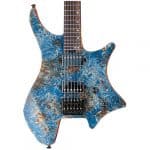 | EART Electric 6-String Electric Headless Guitar | Best on a Budget: Super-cheap model that offers surprisingly clear pickups and premium tonewoods | Check price |
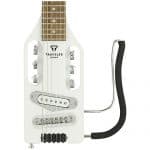 | Traveler Guitar Ultra-Light Electric Headless Guitar | Ultra-Light Weight: Good choice for players who need a guitar that weighs as little as possible | Check price |
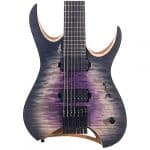 | Mayones Hydra Elite 7 Headless Guitar | Best Premium Seven-String Guitar: Luthier-built quality and custom pickups in a seven-string guitar | Check price |
Strandberg Boden Classic 6 Trem Headless Guitar
Strandberg is the premier brand for headless guitars. The Boden designs blend classic styling and tone with ultra-modern curves. Together, it makes for a headless guitar that looks and feels as beautiful as it sounds.
If you’re looking for a versatile headless guitar, the Strandberg Boden Classic 6 is the best choice on the market. It offers a solid alder body with a roasted maple neck and either a maple or pau ferro fretboard. The maple is bright and snappy, while pau ferro is smooth and warm.
The scale length is a classic 25.5 inches, and the nut measures 1.38 inches wide. The three-piece neck is reinforced with carbon fiber, so it can handle sharp bends from the tremolo at the bridge.
The stainless steel fanned frets are another major plus. Compared to classic nickel frets, stainless steel frets last much longer and provide crisp, accurate intonation.
For pickups, the Strandberg Boden uses a pair of vintage-style single-coil pickups with a humbucker in the bridge. This combination gives you the touch and clarity for clean tones, with all the grit and bite of a humbucker as well. It’s a time-tested combination for genres from blues and country to rock and even metal.
Positives
- Classic tone and styling, with the build quality Strandberg guitars are known for
- Roasted maple and carbon-fiber reinforcement provide a durable fretboard for a great price
Negatives
- 20-inch fretboard radius is rather flat for playing chords on higher frets
- Fanned frets and stainless steel take some getting used to if you’ve never used them before

Legator G6P Electric Headless Guitar
Headless guitars are tough to find on a budget, because the design requires extra care and finesse. However, the Legator G6P provides a comfortable body design, smooth feel and luscious sound for a remarkably affordable price.
The body is solid ash, a versatile tonewood used on some high-end Fender guitars. The five-piece neck uses mahogany and maple for the best combination of feel and tone. Plus, you get a genuine ebony fretboard that sounds crisp yet warm. With the locking nut and bridge, you’ll have great intonation at all times.
The pickups are two Legator passive humbuckers, which provide plenty of output for rock, hard rock and metal. There’s also a master volume knob and three-way selector switch, but no tone control.
With 24 frets and a 14-inch radius, the neck itself is versatile enough to handle any style you want to play. The full scale length is helpful, because it gives you plenty of room for extended licks and solos high on the fretboard. Plus, the abalone fret markers are a premium touch at this price.
Positives
- Locking nut and bridge keep your strings in tune without bulky tuning machines
- Low weight and curved body make it one of the most comfortable instruments to play for long sets
Negatives
- No tone control, which makes it tougher to dial in the perfect sound
- Other electric guitars at this price provide a more balanced pickup set for genres beyond metal and rock

Legator G6OD Electric Headless Guitar
Another option from Legator, the Ghost G6OD blends classic tonewoods with an upfront sound, and a top design that’s sure to turn heads. It’s a good fit for any player with a powerful style who wants a unique guitar to match them.
This guitar includes a genuine buckeye burl top, which offers a rare pattern that stands out from the crowd. Combined with the flashy finishes, it makes the G6OD one of the most unique-looking headless guitars around.
The rest of the body is mahogany, and the neck uses roasted maple and stainless steel frets. Two of the colorways keep the roasted maple for the fingerboard, but ebony is the default option on the black ice top.
With a 25.5-inch scale length and a 14-inch fretboard radius, the neck is versatile enough to play anything from country to blues, jazz or rock. The two humbuckers are built for hard rock and metal — although they can sound nice even without distortion.
Like other Legator guitars, the G6OD includes stainless steel frets with a locking nut and bridge onboard. This is a major plus for a headless guitar, because it keeps everything in tune without constant adjustments.
Positives
- One-piece roasted maple neck feels comfortable and sounds more full than standard maple
- Locking bridge and nut are great for keeping every single string in tune at each fret
Negatives
- Flashy top designs might not suit every player’s taste
- No tone control, which limits your ability to get the right feel out of each pickup

Traveler EG 1 Custom Electric Headless Guitar
While a lot of other headless guitars skip the headstock for aesthetic reasons, Traveler guitars are built with players on-the-go in mind. These guitar models are perfect for any player who needs a compact guitar for travelling, practicing and carrying around.
The EG-1 is Traveler’s classic electric guitar model, with a Les-Paul style body and a single humbucker for sound. It manages to condense a full-length scale into a tiny body, and it weighs less than four pounds for traveling.
The neck and body are mahogany, with a walnut fretboard and metal standalone bridge. The tailpiece sits within the frame of the body, and the tuning machines slot into the core of the guitar. This gives the guitar a clean frame and keeps things quite compact.
With just one pickup and such a tiny body, the sonic palette is a bit more limited than other headless guitar models, but it sounds great for quiet practice and playing on-the-go. If you need to hear yourself without disturbing others, the onboard headphone input is a major plus.
Positives
- Travel guitar frame fits full tuners, a full-length scale and a humbucker without adding too much weight
- Onboard headphone input lets you hear yourself play in any situation
Negatives
- Tune-o-Matic bridge provides good intonation, but is less durable than bridges built into the tailpiece
- Single pickup provides less tonal variety than other headless guitars built for general use

Steinberger Spirit GT-PRO Deluxe Electric Headless Guitar
Steinberger guitars are known for their unorthodox body shape, but the Ned Steinberger brand has a storied history making headless guitars.
The Steinberger Spirit GT-Pro Deluxe is a classic headless guitar that provides a fantastic feel and pickup combo at an attractive value.
With a three-piece maple neck and basswood body, this guitar offers solid tonewoods for its price. The SlimTaper “D” neck and full scale length help the neck feel like any other guitar you’ve played.
There’s also an R-trem tremolo, which lets you add effects and accents to your guitar playing.
The pickup combination is one of the most versatile designs on the market. With two humbuckers and a single-coil in the middle, you can play anything from clean blues to dirty rock to grinding metal. The 5-way pickup selector and master dials for tone and volume get your ideal tone from inside your head onto the stage.
The one major downside of this Steinberger guitar is the body shape. While it’s compact for travel, it’s not really comfortable when sitting down. The Steinberger Spirit GT-Pro includes a folding leg rest, but it feels different from a normal guitar frame.
Positives
- Composite body saves on cost and gives you a unique, powerful tone
- Three Steinberger pickups and 5-way selector give you great control over your sound
Negatives
- Steinberger body shape isn’t really comfortable to play while sitting down
- Engineered hardwood fretboard doesn’t offer the feel and response of genuine tonewoods

Legator G7FP 7-String Electric Headless Guitar
For metal guitar players who want an extended scale guitar, the Legator G7FP is one of the best headless guitar options on the market. This seven-string guitar offers sharp curves and a solid ash body along with a smooth neck that’s optimized for fast playing.
The main advantage of this guitar is the seven-string scale. With a five-piece maple and mahogany neck and an ebony fretboard, it looks and feels like an instrument well above its price. Plus, the frets are fanned for easy sweep picking and accurate intonation across the scale.
The seven-string body also requires extended pickups. There are two Legator humbuckers on this electric guitar — an alnico pickup in the neck, and a ceramic humbucker in the bridge. Both pickups are built for distortion and high gain, although the neck offers a bit more range.
That said, the G7FP isn’t as versatile as other headless guitars and basses. If you want a headless guitar with a more classic voicing, check out a Strandberg or another 6-string model instead. Those instruments will preserve the advantages of a headless design, with more classic pickups, strings and fretboard shapes.
Positives
- Great headless guitar for metal, with powerful pickups and extended scale length
- Slanted bridge provides better intonation at every fret and great string tension
Negatives
- Doesn’t offer the versatility of other headless guitars and basses, like Strandberg
- Fanned fretboard requires most players to make adjustments from their normal string feel

EART Electric 6-String Electric Headless Guitar
The EART Electric 6-string headless guitar is an ultra-budget option that manages to compete with headless guitars well above its price range.
If you need a headless guitar that won’t break the bank, this model is worth a look.
The body is African redwood, which helps it look great and keeps the price down compared to traditional tonewoods. Plus, with a stunning blue top, it definitely stands out in a crowd.
Those extra savings come across in the rosewood fretboard. Rosewood is a premium tonewood known for its smooth feel and warm, rich response. For a guitar in this price range, it offers a fantastic value.
The fretboard itself offers a compound radius, shifting from 9.5 inches to 14 inches as you move up the frets. The extra curve helps with chords down low, while the flatter radius at the top is perfect for single-note runs.
Finally, you get two humbuckers onboard. They’re surprisingly articulate for clean and lightly overdriven tones, with a lot more clarity than other high-gain humbuckers. Compared to other headless guitars, these pickups are great for playing a more versatile style.
Positives
- Rosewood fingerboard is a major plus for a guitar at this price range
- African redwood makes for a beautiful top, great weight and stunning back design
Negatives
- Body design is a bit clunky, without the smooth curves of some other headless guitars
- Pickups and hardware don’t hold up to the standards of other name brands

Traveler Guitar Ultra-Light Electric Headless Guitar
While they don’t have the cachet of a bigger brand name, Traveler acoustic-electric guitars are some of the most portable instruments on the market.
If you need a headless guitar for travel and practice on-the-go, the Ultra-Light Traveler Headless Guitar is one of the best instruments for you.
This tiny product blends tone with maximum portability. The entire instrument is made of maple, with a walnut fretboard and metal leg rest.
It’s made for players who are on-the-move, so it’s not the most comfortable material, but it’s durable enough to handle any travel schedule.
For a headless guitar with almost no weight, this guitar offers a good amount of sustain.
Along with the leg rest, you can play standing up thanks to the strap buttons onboard. The input jack sits on the back of the frame, which keeps it compact and protects the jack from damage.
By the bridge, you get a double-coil humbucking pickup for amplifying your strings. The tuners are on the inside of the guitar body, which saves space and eliminates the need for a traditional headstock. While it’s not the most versatile instrument, for a travel guitar it sounds full and offers a nice range.
Positives
- Low weight and small frame make it the best headless guitar for traveling
- Outstanding tonewoods make the guitar feel comfortable to play and durable
Negatives
- Only one single pickup by the bridge, which makes it tough to play different styles well
- Leg rest is way less comfortable than a traditional guitar body when playing sitting down

Mayones Hydra Elite 7 Headless Guitar
For a guitar without a headstock, the Hydra Elite 7 is one of the most graceful instruments around.
The body is clean and restrained, with smooth curves and a great weight. Compared to some other headless instruments, the frets and strings feel smooth and refined, with a lot of attention paid to the feel.
The body itself is made of mahogany, with an eye poplar material for the top. This makes the guitar punchy and lends great sustain.
On top of the body, you get an ABM fine-tuner bridge, which provides outstanding tuning stability and intonation at every fret.
Mayones also offers a wenge/purpleheart five-ply neck. It’s strong enough to withstand the weight of tuning seven strings, and gives the guitar an eye-catching design feature.
The pickups are two Mayones humbuckers, designed by Bareknuckle pickups. Barenkuckle makes custom-wound pickups by hand in the UK. They’re made for luscious, clean articulation and great attack for metal.
The Mayones treble bleed mod is another major upgrade to this guitar design. This upgrade preserves the treble range, even when you turn down the tone knob. Players who want their phrasing to translate perfectly will really like this pickup mod.
Positives
- Outstanding frets, tuning and pickups make this a really great-sounding guitar
- Reasonable value for a product with such a high price
Negatives
- High price may be way too much for some players to afford
- Some players might want classic features like a maple neck or multiscale bridge

How do Headless Guitars Work?
Headless guitars are like regular electric guitars in many ways, but there are a few key differences between the two. Headless guitars forgo a headstock, and instead run the strings by the bridge of the guitar.
This strategy cuts down on space, and makes headless guitars stand out in a crowd. If you want to look great on stage and turn some heads, then a headless guitar might be the perfect model for you.
The tuning arrangement, however, makes a few things like adjusting your intonation or changing your strings much more difficult. Plus, many manufacturers make headless guitars with a sharp, futuristic design. If you want a more traditional guitar with a wider body and vintage neck, then a headless guitar might not be a good fit.
Let’s take a look at some more aspects of headless guitars and break down what makes them really unique.
Are Headless Guitars Any Good?
Headless guitars, like any other type of guitar, vary widely based on build quality, material and cost. Some premium headless guitars can go head-to-head with custom-built traditional guitars. However, you can also find headless guitars even if you’re on a really tight budget.
If you buy a classic model like a Strandberg Boden, you’ll get a really good instrument. If you want to save money, on the other hand, your instrument might be closer to an average guitar. With that being said, though, there are really great headless guitars on the market if you do your research.
To find the best headless guitars, pay close attention to the construction of the scale. Without a headstock, it’s really important to get a guitar with a strong, durable neck and bridge. Using a cheap material for the bridge or neck reinforcement can damage your guitar and shorten its lifespan.
Beyond the areas specific to a headless guitar, evaluate every model like you would with a regular guitar. Examine the tonewoods used, think about the pickup configuration and see how the guitar neck feels in your hands. Once you get used to playing a guitar without a headstock, you’ll be able to easily tell great headless guitars from the other mediocre models.
Thankfully, there’s no need to worry about headless guitars in general. While the design might look strange, and you might hear horror stories about the tension on the truss rod, headless guitars are just as safe and durable as their regular counterparts.
Some of the world’s most famous guitar players love headless guitars. So, if you’re worried about a headless guitar not being any good, you can put those fears to rest.
Are Neck-Through Guitars Better?
Neck-through guitars are an alternative form of guitar construction. Instead of stopping at a heel socket, the neck runs all the way through the body. Bolt-on and set necks join to a separate body piece, while neck-through guitars have two “wings” on either side of the central shaft.
Compared to traditional styles, neck-through guitars are really durable and resistant to changes in environment and string tension. In fact, it’s more common to see this design on a bass guitar, because the construction style can withstand the extra tension of bass strings.
With headless guitars, it’s a similar story. The extra strength of a neck-through guitar adapts well to the challenges of a headless guitar body. Without a headstock, having a strong central core is really important.
This durability comes in handy if you want a guitar that will last you a lifetime. When treated properly, neck-through guitars can withstand grueling touring environments and still sound great.
Plus, without a bulky joint, you get much better access to the top of the scale. If you like to play screaming solos high up the fretboard, a neck-through guitar will give you better clearance than a bolt-on design. Even at the very top fret on your instrument’s range, you’ll have a lot more space to maneuver.
From a design standpoint, these guitars offer some major advantages. Before you purchase a neck-through guitar, however, there are a few significant drawbacks to be aware of.
The biggest downside of this guitar style is the repair situation. Because the neck runs all the way through the body, making repairs to the neck or top is really difficult. In fact, many instrument shops may refuse to repair neck-through guitars altogether. Even minor repairs to the scale, tuning, tremolo, strings and frets can be trickier than other guitars.
Along with being tougher to repair, a neck-through design tends to drive up the price of the instrument. Shaping the core plank and attaching the wings requires a lot of time and expertise, and that gets passed onto the buyer. If you’re looking at one of these guitars, make sure you’re really committed to go all the way.
What is the Purpose of Multiscale Guitar?
A multiscale guitar is a unique style found with some headless guitars. While it requires a different way of playing the instrument, a multiscale setup can benefit your tuning and intonation, so every string sounds clear and crisp.
The core principle behind a multiscale guitar starts at the bridge. While normally the bridge is angled straight against the scale, a multiscale guitar places the bridge at a slant. This makes the scale longer for every string on the bass side, and the top string has a much shorter scale than the other strings.
The exact measurements vary, but it’s common to see multiscale guitars ranging from 25.5 inches to 28 inches or longer. The more slanted the bridge is, the more different the scales will be between the bottom and top strings.
Using a longer scale for the lowest strings makes them ring with more punch and bass response. Plus, it raises the string tension a bit, so they feel taut for the full length of the instrument. With the longer scale length, you can tune your instrument to drop tunings, extending your range without compromising tension and tone.
At the other side of the bridge, you’ll find a shorter scale length to provide a looser, more comfortable feel. However, almost all multiscale guitars still use a full scale length for each string. It’s common to find the top string ranging between 24.5-25.5 inches, no matter how long the scale is at the bottom string.
This gives you the rich harmonic overtones of a classic electric guitar, without sacrificing the flexibility and resonance of a unique scale length. If your guitar has a tremolo, this can also preserve your intonation and tuning through bends.
A lot of different headless guitar brands manufacture multi-scale models. They’re also more common on extended-range instruments compared to 6-string models. Look to brands like Strandberg, Boden and Kiesel (especially the Allan Holdsworth models) if you want a multiscale guitar.
Alternative Headless Guitar Brands
While the guitar brands that we’ve already examined make some of the best headless guitar models anywhere, there are plenty of other manufacturers that you should check out for their guitars. Headless instruments from these brands are known for features like their great pickups, tremolo units, material and more.
Here are four more manufacturers making outstanding instruments for guitar players today. Their headless guitars run the gamut from classic and versatile designs to hardcore instruments made for metal and hard rock.
Teuffel Guitars
Luthier Ulrich Teuffel pushes a lot of boundaries with his guitars. Headless models like the Birdfish and Tesla are some of the most eclectic electric guitar designs around. If you’re looking for a guitar made for playing your own unique way, then Teuffel’s guitar designs might appeal to you.
With ethereal bodies, custom-made designs and precise frets and pickups, the Birdfish and Tesla stand out from the pack.
The Birdfish, for example, uses a modular body and percussive single-coil pickups, so you can mix and match material without adding too much weight. The 5-way selector switch provides the perfect amount of control for each pickup.
The Tesla’s extended upper bout provides more weight while preserving balance well, so the guitar feels like it was made to play standing up.
While Teuffel’s guitars cost too much for some players to afford, they’re built extremely well and provide fantastic playing experiences. If you want a headless guitar built with meticulous attention, you can’t beat Teuffel’s product list.
Kiesel Guitars
Kiesel is an established name in the headless guitar world. Players like Joe Walsh and John McVie have endorsed the brand’s product line, so you can be sure you’re getting one of the best headless electric guitar brands around.
Kiesel offers almost every model name in a headless variant. So, whether you want a classic single-cutaway design or an aggressive metal model, you’ll be able to get it from Kiesel.
The most popular models, like the Delos, Zeus, and Leia, offer more classic body shapes with humbuckers and fuller bodies. If you want a more aggressive option, you can look at the Vader or Osiris models. Both are stylized double-cutaway guitars, while the Vader offers premium stainless steel frets.
The Kiesel Allan Holdsworth signature model is another great product to check out. With two humbuckers, a Hipshot bridge and a hard rock maple neck with stainless steel frets, it’s a compact instrument that still oozes premium value. Plus, like many Kiesel guitars it’s built at the Kiesel factory in Escondido, California.
Rick Toone Guitars
Rick Toone’s guitars combine a futuristic aesthetic with a bold, visionary ethos. If you want a guitar with features like eight strings or a fretless design, Rick Toone might have the model for you.
Models like the Wingspan 8, Little Wing 8 and Walrus push the boundaries of what a guitar can be. Designs include swooping curves and cutaways, with premium tonewoods and hardware. They’re available with or without frets, and the Walrus can be used for synths as well as traditional guitar parts.
While Toone’s guitar designs aren’t for the faint of heart, they’re perfect for players who want to open up new frontiers for musical exploration. If you can afford a luthier-built guitar, you should definitely check Toone out.
Marconi Lab Guitars
Marconi Lab guitars are custom-built axes that blend classic performance with modern style. If you want the unique feel of a custom guitar without sacrificing a more traditional feel, Marconi Lab is a brand you should check out.
Marconi offers a broad range of guitars, with the majority centered around its Ego model. The Ego provides a classic double-cutaway frame that you can then customize with different pickups, necks and hardware.
If you want a balanced, classic guitar, look for single-coil pickups or a combo of single-coils and humbuckers. Some versions include two humbuckers for a more powerful attack. You can also adjust options like the bridge and frets, with multiscale and tremolo alternatives available.
Bottom Line
After evaluating every review, we settled on the Strandberg Boden Classic 6 as our pick for the best headless guitar on the market. It’s an outstanding instrument that’s suited well to almost any style.
If you want a different vibe, look at more aggressive guitars like the Mayones Hydra Elite 7 and the Legator G6OD. For a travel guitar on a budget, the Traveler Ultra-Light Electric Headless Guitar is your best bet.
Do you use a headless guitar for travel or everyday use? What’s your favorite aspect of a headless guitar? Let us know in the comments below.
